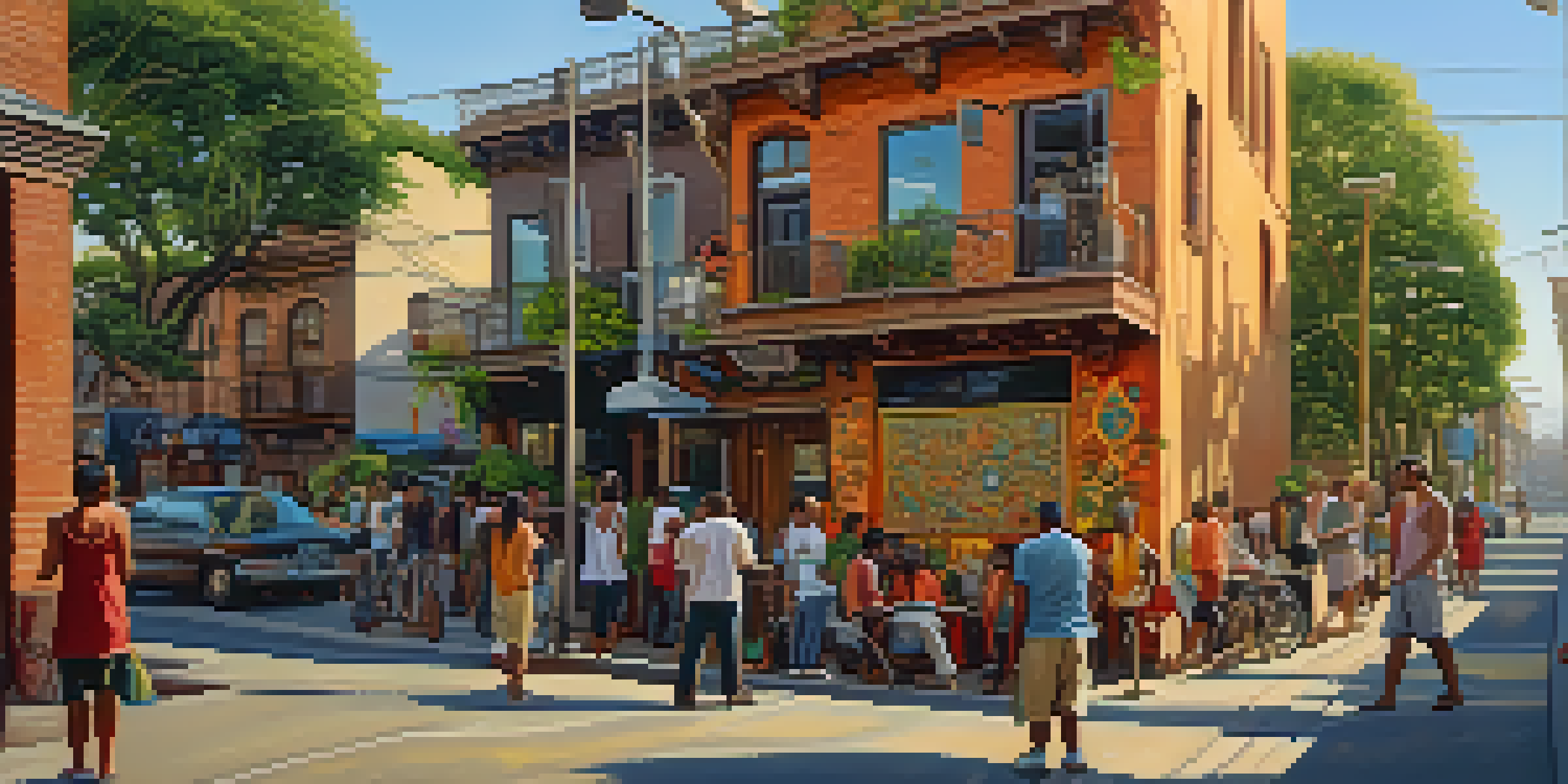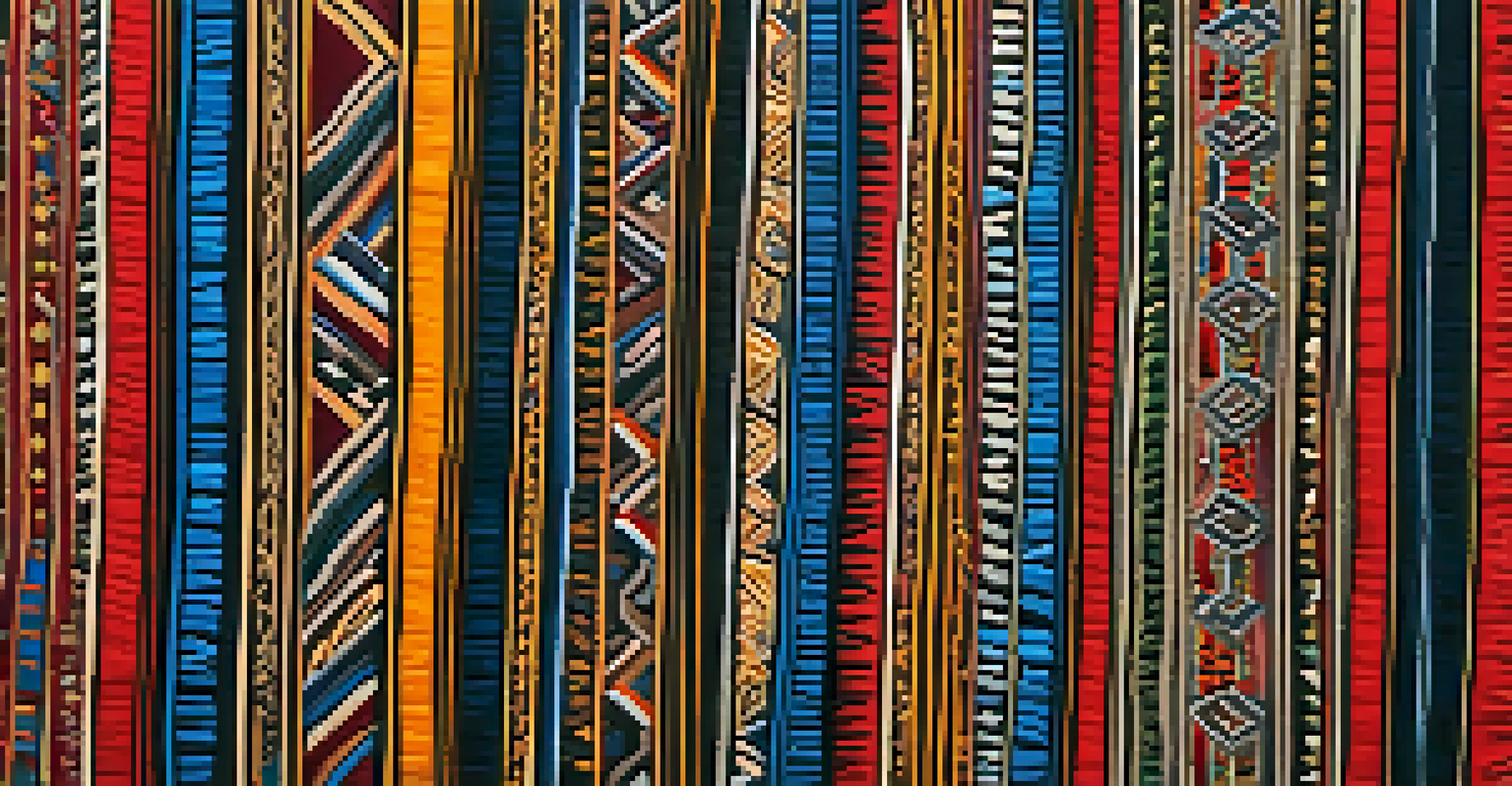The Impact of Culture on Subconscious Artistic Interpretation

Understanding Culture's Role in Art
Culture is the lens through which we view the world, influencing our thoughts, beliefs, and, importantly, our art. Every piece of art carries the fingerprints of its cultural background, whether it's a painting, a sculpture, or a piece of music. For instance, indigenous art often reflects the values and traditions of the community, showcasing stories that resonate deeply within that culture.
Art is the most beautiful of all lies.
When artists create, they subconsciously draw from their cultural experiences, which can shape the themes and emotions expressed in their work. This influence can manifest in various ways, including color choices, subject matter, and even the techniques used. A simple landscape painting can evoke different feelings depending on the cultural context in which it was created.
Understanding how culture impacts art allows us to appreciate the diverse narratives that different artists bring to the table. By acknowledging these cultural influences, we can enhance our viewing experience and deepen our connection to the art itself.
The Subconscious Mind and Artistic Expression
The subconscious mind plays a crucial role in how artists interpret their cultural influences. It acts as a storage room for experiences, memories, and emotions, which can all surface in creative expressions. When an artist creates, they often tap into this reservoir, sometimes without even realizing it, leading to artwork that reflects their inner thoughts and cultural background.

For example, a painter might depict a sunset that reminds them of their childhood, subconsciously infusing that artwork with nostalgia and warmth. This connection is not merely personal; it speaks to shared experiences within a culture, allowing viewers to connect with the piece on a deeper level. The beauty lies in how these subconscious elements can resonate with others, even those from different backgrounds.
Culture Shapes Artistic Expression
Art reflects cultural backgrounds, influencing themes, emotions, and techniques used by artists.
Artists, therefore, become conduits for their culture, channeling both conscious and subconscious feelings into their work. This dynamic interplay can produce art that is rich in meaning and layered with cultural significance.
Cultural Symbols and Their Interpretations
Cultural symbols are powerful tools in artistic interpretation, often loaded with meanings that vary from one culture to another. Consider the color red, which can symbolize love and passion in one culture, while representing danger or warning in another. Artists use these symbols to communicate messages that resonate within their cultural context.
Every artist dips his brush in his own soul, and paints his own nature into his pictures.
When we view art, recognizing these symbols allows us to understand the deeper implications of a piece. An artwork filled with cultural symbols can evoke specific emotions or provoke thoughts tied to those cultural narratives. This adds layers of complexity to the viewer's experience, encouraging a more profound engagement with the art.
By acknowledging the cultural symbolism present in art, we can appreciate the nuances that exist within various artistic expressions. This understanding fosters a richer dialogue between the artwork and its audience, bridging gaps between different cultural perspectives.
Examples of Cultural Influence in Famous Artworks
Throughout history, we can see how culture has shaped artistic expression, as seen in renowned artworks. Take Vincent van Gogh's 'Starry Night,' for instance—his unique brushwork and use of color reflect his emotional state while also hinting at the influences of his Dutch heritage. This piece evokes a sense of wonder, merging personal and cultural interpretations seamlessly.
Similarly, Frida Kahlo’s self-portraits are deeply intertwined with her Mexican heritage, showcasing elements of folk culture, identity, and personal suffering. Her art goes beyond the canvas, offering a glimpse into the cultural struggles and narratives that shaped her life. This powerful connection allows viewers to engage with both the artist's personal story and the broader cultural context.
Globalization Influences Art Today
The interconnectedness of cultures allows for innovative artistic expressions while raising concerns about cultural appropriation.
Examining these examples highlights how culture can serve as both a backdrop and a driving force in artistic creation. It encourages us to look beyond the surface and appreciate the rich tapestry of influences that give art its meaning.
The Role of Globalization in Artistic Interpretation
Globalization has dramatically impacted the way culture influences art, creating a melting pot of ideas and styles. Artists today can draw inspiration from a vast array of cultural influences, leading to innovative and hybrid forms of artistic expression. This interconnectedness allows for a more diverse exploration of themes and techniques, enriching the art world.
However, this blending of cultures can also lead to challenges, such as cultural appropriation, where elements of one culture are used without proper acknowledgment or respect. Navigating these complexities is essential for artists, as they strive to honor the origins of the influences that inspire their work while also pushing creative boundaries.
As globalization continues to shape artistic landscapes, it becomes increasingly vital for both artists and audiences to engage in thoughtful conversations about cultural influences. This dialogue can deepen our understanding and appreciation of art in an ever-evolving global context.
Art as a Reflection of Cultural Identity
Art often serves as a mirror, reflecting the cultural identity of the artist and the society they inhabit. By examining the themes, techniques, and subjects in an artist's work, we can gain insights into the values, beliefs, and struggles of their culture. This reflection can be particularly powerful in times of social change, as artists use their medium to comment on or challenge the status quo.
For instance, street art often emerges from urban environments, capturing the voice of marginalized communities. These artworks can convey messages of resistance, hope, and identity, acting as visual narratives that resonate with a broader audience. In this way, art becomes a tool for cultural expression and social commentary.
Art Reflects Cultural Identity
Art serves as a mirror of cultural identity, providing insights into societal values and struggles, particularly in times of change.
By analyzing how art reflects cultural identity, we can appreciate the stories and experiences that shape our world. This understanding fosters empathy and connection, bridging divides and promoting a more inclusive appreciation of diverse artistic expressions.
The Future of Culture and Artistic Interpretation
As we move forward, the relationship between culture and artistic interpretation will continue to evolve. With advancements in technology and communication, artists have unprecedented access to global influences, allowing for new creative possibilities. This dynamic landscape presents exciting opportunities for artists to explore and reinterpret their cultural narratives in innovative ways.
However, as we embrace this evolution, it’s essential to remain mindful of the cultural roots and histories that inform artistic expression. Artists and audiences alike must engage in conversations about cultural sensitivity and respect, ensuring that inspiration does not come at the cost of cultural appropriation.

Ultimately, the future of art will likely be characterized by a rich interplay between tradition and innovation, inviting us to explore the depths of cultural influence on artistic interpretation. This journey will challenge us to remain curious and open-minded, fostering a deeper appreciation for the diverse tapestry of human creativity.